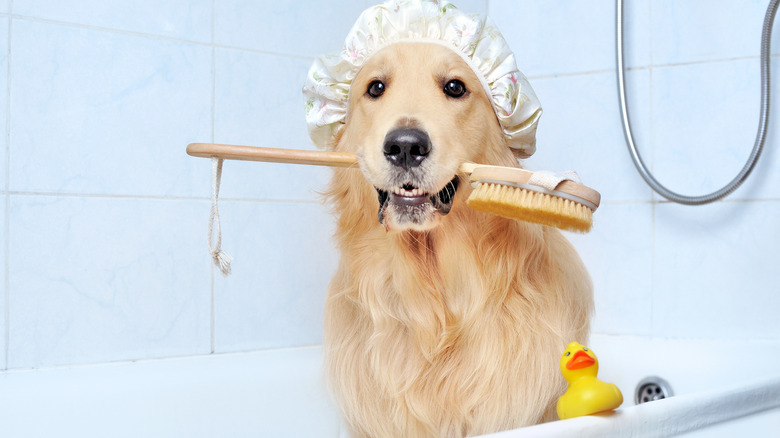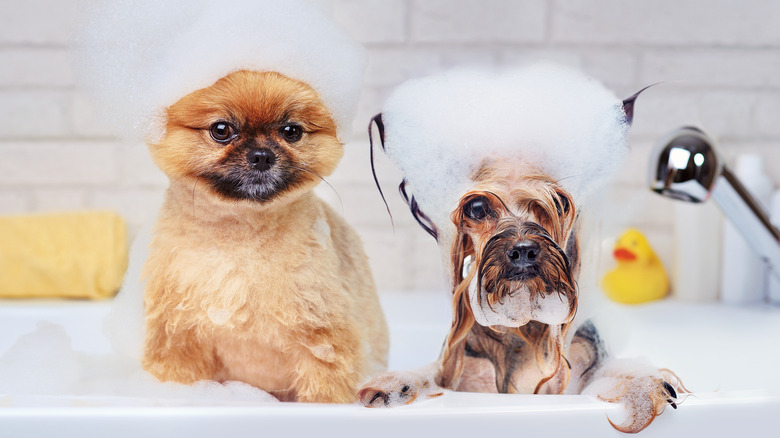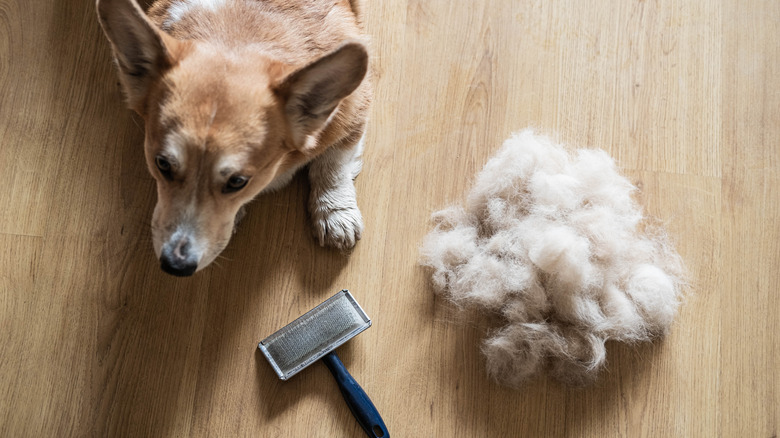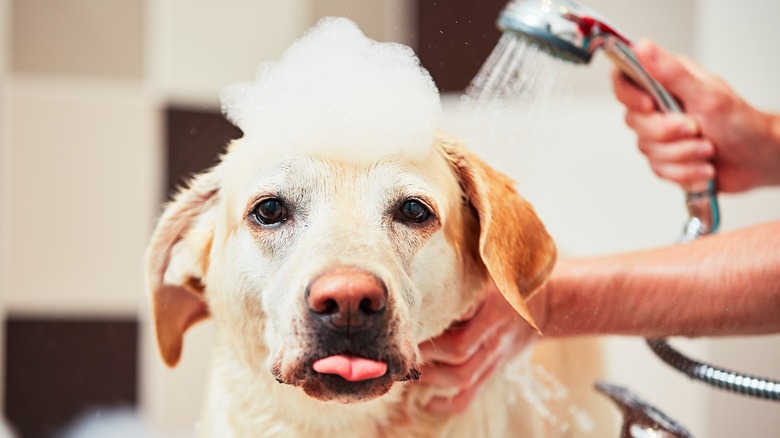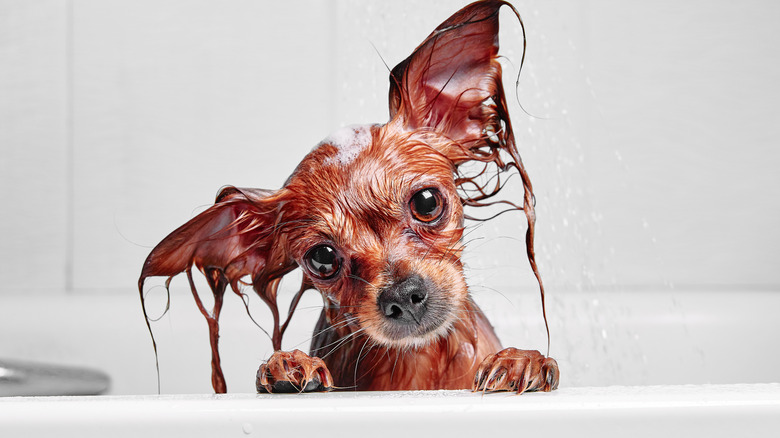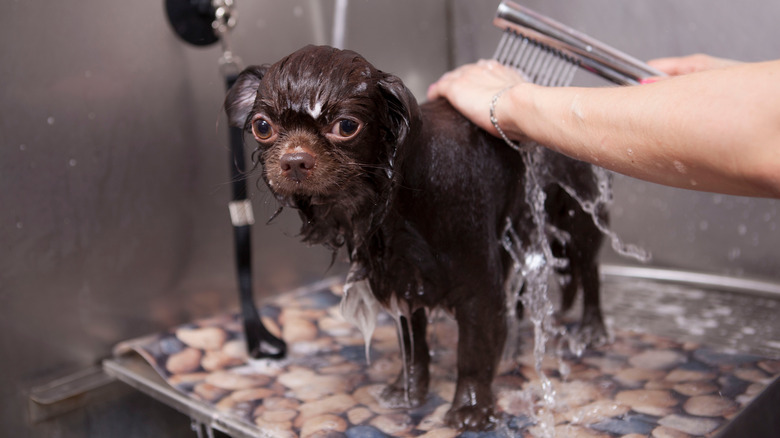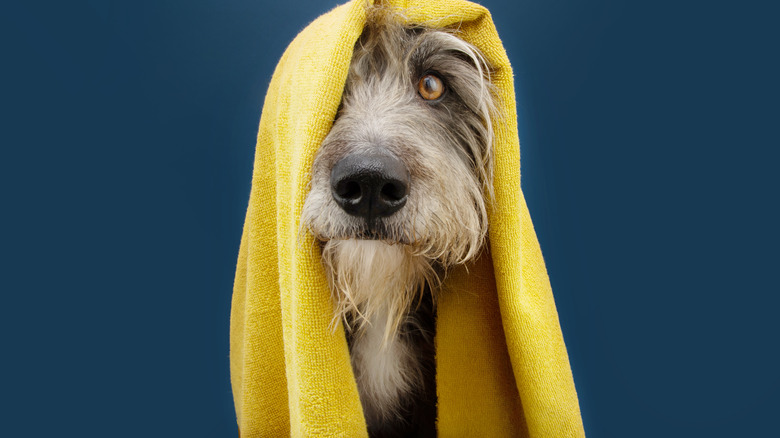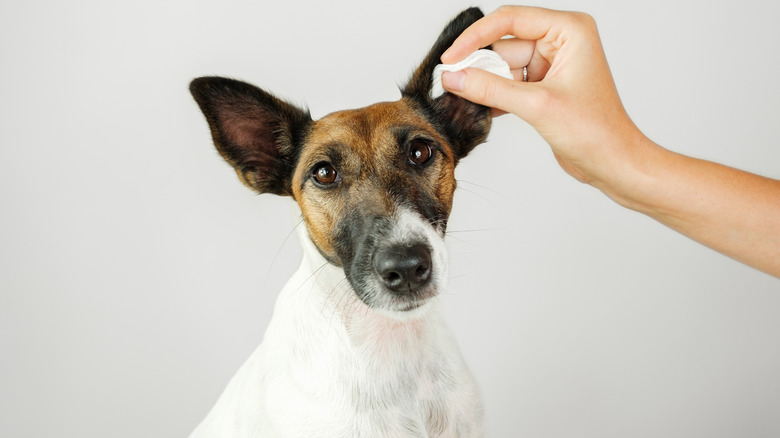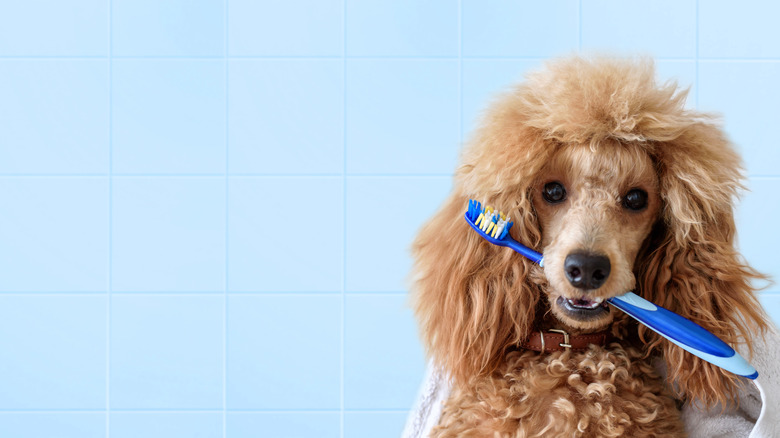How To Properly Clean Your Dog
We may receive a commission on purchases made from links.
Every pet parent is likely familiar with the battle of bath time. Unless you're lucky and your dog is one of the few that loves or even just tolerates baths, keeping your dog clean can be a struggle. However, there are many benefits to regular baths and hygiene habits that improve the health and quality of life for your four-legged friend, as per The Dog Stop. For starters, you can treat pathogens and small insects, like fleas, that are attracted to your pet while also identifying potentially harmful skin problems as soon as they begin. Baths can also reduce shedding and improve coat health. Finally, grooming nails prevents posture issues, while cleaning ears prevents painful infections. Regular bathing doesn't just benefit your dog either — you benefit as well from a pleasant-smelling pet while your home benefits from collecting less dirt, pet dander, and dog fur.
Petco points out that you should be washing your dog about once a month. The frequency of other hygiene-related activities depend on the type and the needs of your dog. For regular at-home dog grooming, make sure to have a dog-approved shampoo and conditioner on hand in addition to a brush, towel, wash cloth, cotton balls, ear cleaning solution, and dog-approved toothbrush and toothpaste. Scroll through the following guide for some tips on how to properly clean your dog.
1. Choose the right shampoo and conditioner
Before you even coax your pup into the bathtub, you'll need to choose a shampoo and conditioner that are appropriate for dogs, according to Daily Paws. Linda Easton from International Professional Groomer explains, "Dogs have different pH than people do in their skin. So, they're actually more alkaline." For this reason, shampoos and conditioners made for humans will aggravate a dog's skin.
The products you purchase will also depend on your dog's age and specific skin needs. For example, most puppy shampoos are designed to be gentle if they come in contact with your pet's eyes during cleaning. A shampoo created for older dogs will likely take in the increased need for moisture. If your dog has sensitive skin or is prone to rashes and/or skin allergies, you should search for products targeting these conditions. You should always make sure to have a conditioner on hand to rehydrate after shampooing as well.
2. Before bathing, brush your dog
Most people aren't aware of or skip this step prior to plopping their pup in the bathtub. However, Furminator explains the importance of giving your dog a good brushing before bathing them. First and foremost, brushing gets rid of any loose fur that will likely come off during the bath anyway. Not only does this make your job easier, it also prevents your drain from getting loaded with massive fur clogs.
Detangling mats of fur is also important for ensuring that the shampoo works its way into your dog's coat and cleans properly. The same goes for when it's time for the conditioner — smooth, unmatted fur will be easier to hydrate. If you don't remove knots before bathing, they will also be more stubborn to get out when your dog's fur is wet. In some cases, it may be necessary to snip knots and tangles with scissors if brushing doesn't work.
3. Use lukewarm water
You'll want to think like Goldilocks and the three bears when it comes to water temperature — not too hot and not too cold. Whether you bathe your dog in a full bathtub or with a shower hose, always test the water to make sure it is lukewarm before exposing your dog to the water, as per the Daily Puppy. Unfortunately, this means that a bath with the garden hose, which doesn't allow for regulating temperature, should be avoided at all costs.
There are multiple reasons for using warm water. The first is simply a matter of comfort. Like us, dogs are sensitive to temperature and a bath that is too hot or too cold will be unpleasant for them. Hot water will also dry out your dog's skin and remove moisture and natural oils while cold water won't be as efficient at cleaning your pet's fur and skin.
4. Avoid pouring water on your dog's head
You may be tempted to wash your dog's head while bathing them, but this is a big no-no, explains Preventive Vet. You should avoid spraying or submersing your dog's head in water as this can prove harmful to the sensitive areas of the ears, nose, and eyes. Not only can water and soap irritate these areas, getting water in the ears can lead to infection if not dried properly. To be on the safe side, you can always place cotton balls in your dog's ears before the bath or use a bathing cap to protect them from accidental exposure to water.
The best way to clean your pup's head is with a wet washcloth, according to Pedigree. Make sure to wring out the water before wiping down your dog's head and face to prevent run-off from making its way into the ears or eyes. For the areas around the eyes, use a dampened cotton ball. This also works well for stubborn bits of dirt or gunk on the face.
5. Rinse thoroughly after shampooing
Many people make the mistake of under-rinsing their dog after applying shampoo and conditioner. This step of the process is incredibly important to ensure soap doesn't stay on your dog's skin and fur, as noted by BeChewy. When soap is left behind after a bath, it can irritate the skin and lead to rashes and infections. Due to the thick nature of dog fur, it is also quite common for soap residue to remain even after rinsing. This makes it even more important to pass every part of your dog's body (minus the head!) through clean water multiple times before calling it a day.
Certain areas of the body tend to hold onto soap more readily than others and include the armpits, groin, and area underneath the tail. Before removing your dog from the bath, do a quick check with your hands to pinpoint any remaining soapy zones. As a general rule, the water should run clear from your dog's body into the shower or tub without any sign of suds.
6. Make sure to properly dry your dog
Following a bath, it is necessary to thoroughly dry your dog before letting them run off, shares Good Housekeeping. Not only does this prevent them from suffering from chills as they dry (depending on the surrounding temperature), it also prevents skin problems resulting from spending too much time with wet fur and skin. PetSmart veterinarian Jennifer Freeman explains that "damp spots in the undercoat can lead to hot spots," which is a painful condition also known as acute moist dermatitis.
Simply rubbing your dog try with a towel should be enough to prevent the potential for hot spots and to help them dry faster. You'll want to remove as much moisture as possible before allowing them to air dry. You can also encourage your dog to shake off several times before toweling them to reduce the amount of water that needs to be absorbed from their coat. Nowadays, you can purchase specialized towels that are extra-efficient at absorbing moisture and leave your dog as dry as possible.
7. Clean your dog's ears
Dog ears can be a breeding ground for dirt, earwax, and other yucky gunk that needs cleaning on a regular basis. The American Kennel Club points out that it is important not to clean your dog's ears excessively to avoid irritation. You'll know it's time for an ear cleaning when you notice a build-up of dirt in the ear canals. You should always check your dog's ears following a bath to see if they need cleaning. Note that a strong odor and inflamed inner ear may indicate a serious medical condition and will require the attention of your vet.
For regular cleaning, you'll need an ear-cleaning solution designed for dogs and a cotton ball or small cloth. Squeeze a bit of solution into your dog's ears and let it work — the amount of time the solution needs to sit in the ear depends on the individual product and will likely be indicated in the instructions, but is typically 30 seconds to one minute. Then take the cotton ball or cloth and wipe out the ear canals, taking care not to probe too deep, which may cause discomfort or injury.
8. Don't forget to brush your dog's teeth
You should be brushing your dog's teeth much more frequently than you bathe them — ideally, once daily, as per WebMD. Daily brushing is just as beneficial to dogs as it is to us in preventing cavities, gum disease, tooth decay, and other painful and damaging dental conditions. Dental treatments for dogs are also incredibly costly, making it a wise choice to brush your dog's teeth on a regular basis.
To carry out this task, you'll need a dog-approved toothbrush and toothpaste. Note that you should never use human toothpaste as certain ingredients aren't compatible with a dog's digestive system. Once you have your supplies ready, sit or kneel in front of your pup, lift up the side of their mouth, and brush gently in circular motions. Make sure to pass the toothbrush over the gums as well as each individual tooth while taking care to target any teeth with plaque. You may need to work up to this with small steps if your dog is initially resistant or displays anxiety. Offering treats is a great way to form a positive association with the potentially unpleasant act of teeth brushing.
